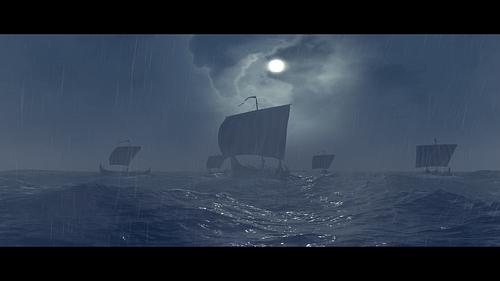Bardr mac Imair (c. 873-881 CE, also known as Barid mac Imair, Barith, Baraid) was a Viking king of Dublin, son of the Viking king Imair (Imar, Ivan) who founded the Ui Imair Dynasty in Ireland. Bardr became king in Dublin after Imair's death. He engaged in military campaigns against the Irish monasteries and other religious institutions and is best known for his raids on various communities for plunder which was brought back to Dublin. He is known as a Viking sea-king based on his 873 CE raid on the Kingdom of Munster.
He died in 881 CE after one such raid on the oratory of St. Cianan or St. Ciaran, depending on different sources, in Dunleek, Meath. His death was attributed to an act of God and the saint in punishing Bardr for desecrating sacred sites for plunder. Bardr was succeeded by an unnamed king and then by his brother Sichfrith mac Imair (c. 883-888 CE) who continued his basic policies.
Little is known of Bardr's life because his biographers were the monks and clerics of Ireland who only took note of him in reference to his raids on their churches and monasteries. The little information available on him depicts him consistently as “a great Viking Tyrant,” but this is to be expected when one's life story is written by one's enemies. Even so, there are other Norse leaders mentioned in the Irish chronicles who are not so consistently depicted as brutal marauders and so it may well be that Bardr was as ruthless as the clerics claim.
The Vikings in Ireland
The various chronicles of the Irish during the Viking Age are never very flattering to the invaders and with good reason: the Vikings disrupted life in Ireland beginning in 795 CE with the sacking and burning of the monastic island of Rechru (Rathlin) followed shortly after by the destruction of St. Patrick's Island, one of the most revered monastic sites, in 798 CE. Viking raids would continue almost annually until 842 CE. It should be noted, however, that this date is only accepted as concluding the Viking raids because it corresponds to the rise of the Viking Kingdom of Dublin and a decrease in raids on Ireland from overseas; it does not signify an end to Viking raids or hostilities between the Vikings and the Irish.
The Vikings had first struck Britain in 793 CE in a bloody raid on the abbey of Lindisfarne and they would continue their attacks there while simultaneously raiding Irish sites. Their choice of monasteries most likely had little to do with religious differences and everything to do with easy access to rich plunder and food supplies. The monasteries and abbeys were often located along the coast and lent themselves to strikes from the sea.
The early raids were quick forays into Britain and Ireland in which the Vikings, in one or two ships, would strike quickly and depart with their stolen goods. By 807 CE, however, they were engaging in highly concerted efforts involving more ships and larger contingents. Between 811-822 CE, they had sacked and burned monasteries from Inismurray, off the coast of Sligo in the north, to Cork in the far south.
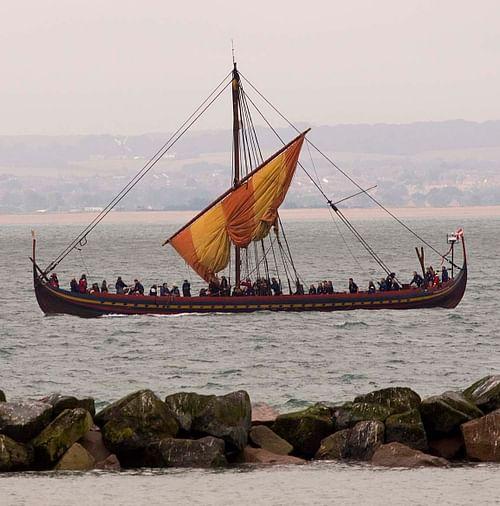
Their goals had advanced from portable plunder and food to captives they could sell into slavery or ransom back to their families. This same paradigm was held to with religious relics taken from churches and monasteries which, earlier, seem to have been stolen for the precious metal they were made from and jewels which adorned them but now were taken to be ransomed back.
The raids continued in attacks on Derry (833 CE) and Glendalough (834 and 836 CE) which prompted the monks to construct the now famous Round Towers. These structures were built with the doorway one floor up accessible by a ladder. When a Viking raid seemed imminent, the monks could flee to the Round Tower with the sacred books and relics and pull the ladder up. Each floor of the tower was also accessible only by ladder and each of these could be hauled up to the next floor if the one beneath were compromised.
The Viking raiders had already made a significant impact on the lives of the Irish but they had not yet made inroads into the country at large. Scholar Donnchadh O'Corrain notes how “no Viking is named in the Irish records before 837 and no king before the mid-ninth century. They kept to the edge; hardly ever much more than 30 kilometres from navigable water” (Sawyer, 87). This was the paradigm the Irish had become used to, but it was about to change.
The Annals of Ulster record 840/841 CE as the first year the Vikings overwintered in Ireland and the appearance of the first Viking longphort (naval base). The longphorts were built to protect the Viking ships but also for defense against land attacks. The entry in the Annals from 841 CE reports a longphort at Dublin and then, in 842 CE, the entry reads, “The heathens are still at Duiblinn” (842.2). Now the Vikings could raid at will, not only during certain seasons, and launched raids against the lands of the Irish Ui Neill dynasty at will.
The Ui Neill were attempting to consolidate their power in the north and south of Ireland through the rule of a High King of Tara, chosen alternately from the northern and southern branches of the clan, and they fought back effectively. In 848 CE the Southern Ui Neill High King Mael Sechnaill I (r. c. 846-862 CE, father of the later High King Flann Sinna) defeated the Viking forces in battle at Dublin, killing 700 of them, and destroying the longphort settlement.
The Viking forces at this time were not organized under a single leadership but seem to have followed the commands of a local leader. In 849 CE a fleet of ships from Denmark arrived in Ireland to impose order on the Norse raiders there. The struggle between the Danes and the Norse of Ireland “disturbed the whole country,” according to the Annals of Ulster, until the Danes were driven off sometime in c. 852 CE. After the Danes had left, however, the Norse were given no time to resume their former raids as a new figure arrived who would change the Irish landscape permanently.
The Coming of Amlaib Conung
While the Norse had been conducting their raids in Ireland, other Viking armies had been at work elsewhere in Britain and Scotland and other regions. In 853 CE a Viking prince named Amlaib Conung (r. 853-871 CE) arrived in Ireland. His name means Amlaib the King, and he is sometimes referred to as Olaf and associated with the Viking sea-king Olaf the White (though this claim is challenged).
Who he was and whatever he did prior to this time is unknown but he was clearly a powerful figure. The Norse instantly submitted to his rule, and the Irish were compelled to give him tribute. Amlaib is called “son of the king of Laithlind” in the annals and this is thought to correspond to Nordic Scotland and not, as previously thought, to Norway.
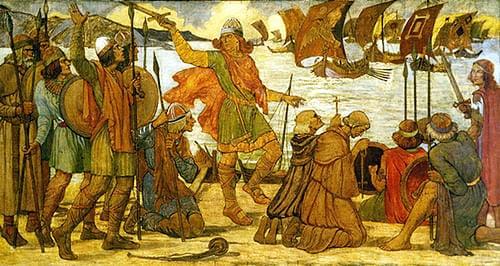
Amlaib organized the Norse in Dublin as their first king and then left for military campaigns in Britain. When he returned in 857 CE, it was in the company of two other princes (or at least nobles) named Auisle and Imair who are called his “brothers” in the annals; whether this means they were brothers by blood or brothers-in-arms is unclear.
The Kings of Dublin
Amlaib, Auisle (r. 863-867CE), and Imair (r. 863-873 CE) ruled Dublin as co-kings beginning in 863 CE but even before Auisle and Imair were elevated by Amlaib to kingship they took part in and coordinated the military campaigns of the Norse in Ireland far more effectively than had been done in the past. There were now well-planned military expeditions instead of hit-and-run raids, and the spoils of these battles went to the treasury of Dublin instead of being divided among a local war-chief and his band.
The difference in before and after Amlaib is apparent in the raids on settlements in Brega by the Norse of Dublin in 856 CE – when Amlaib was still in Britain – which followed the traditional style established, and the concerted military campaign led to victory by Amlaib and Imair against the Norse-Gaels of Munster in 857 CE.
In 859 CE Amlaib and Imair joined forces with Cerball mac Dunlainge, King of Ossory (842-888 CE), a small kingdom near Munster, in an attack on the High King Mael Sechnaill. They were defeated, and Cerball later sued for peace and submitted to Mael Sechnaill, but the kings of Dublin continued to make and break alliances as they fought with and against various Irish kings.
In c. 862 CE, Aed Findliath (r. 862-879 CE) succeeded Mael Sechnaill as High King of Tara and allied himself with Amlaib, Auisle, and Imair as he launched attacks on the Kingdom of Mide (Meath). By 866 CE Aed Findliath was their enemy and destroyed the longphorts of Amlaib all down the northern coast.
The Norse retaliated in 867 CE with a campaign against the Irish, and the Irish responded by burning Amlaib's fortress at Clondalkin. Amlaib and Imair then sacked and burned the monastery of Armagh, sacred to the memory of St. Patrick, and carried off almost 1,000 citizens to be sold as slaves. This act was considered a great sacrilege, but Amlaib had been guilty of an even greater one earlier.
In 863 CE Amlaib, Auisle, and Imair had led an expeditionary force into the Boyne Valley where they raided the megalithic tombs (such as Newgrange and Knowth) and carried off anything of value. The valley was not only the site of the ancient Neolithic tombs but also of those of the high kings of Ireland. The annals only record the sacrilege of the heathens in desecrating the tombs and name only the leaders, but it is possible, even likely, that the sons of these leaders – including Bardr – took part in the campaign. Either before or after their sack of the tombs, Amlaib's forces also defeated the kings of Brega and Leinster.
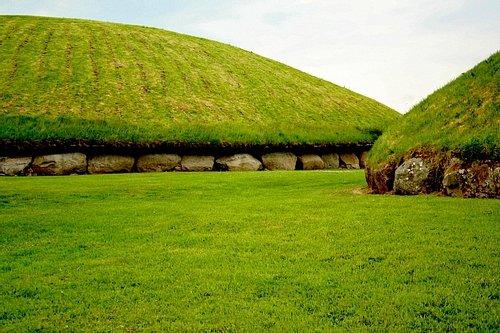
In 867 CE Amlaib and Imair killed Auisle in a dispute over Amlaib's wife. The Fragmentary Annals of Ireland state that the two brothers had already decided to kill the third when Auisle admitted an affair with Amlaib's wife; Amlaib then killed him, slaughtered his followers, and took all his goods (347). Amlaib continued to war with Aed Findliath and others while also conducting campaigns in Scotland. He vanishes from the historical record in 871 CE and is presumed to have died in battle there.
Imair then founded the Ui Imair dynasty which would control the sea routes, western Scotland, and parts of Britain through the 12th century CE. Imair has often been associated with the famous Viking leader Ivar the Boneless (d. 870 CE) who was part of the leadership of the Great Army of 865 CE which campaigned in Britain. Led by Halfdan Ragnarsson (also known as Halfdane, c. 865-877 CE) and Ivar, this army was the best organized and most effective Viking force to invade Britain up to that date.
It is possible that Ivar and Imair are the same man, but no scholarly consensus has been reached. The probability is great, however, that the leader who so effectively organized the Norse in Ireland is the same as the one who did so in Britain; especially so when one considers that Ivar and Imair are versions of the same name.
Imair is said to have died in 873 CE as King of the Norsemen of All Ireland and Britain. After his death, power passed to his son Bardr, who most likely had been accompanying him on campaigns for some time.
Bardr's Reign
As noted, Bardr most likely took part in the campaign of the Boyne Valley in 863 CE but he is first recorded by name in 867 CE where he is called a Jarl of Laithlind (an earl) who was attacked, along with another Jarl named Haimar, in an ambush by the men of Connacht. Haimar was killed, but Bardr escaped and later would return. In 872 CE the Fragmentary Annals record a raid he led on the islands of Lough Ree and the Kingdom of Magh Luirg (Moylurg), both in Connacht. No mention is made of plunder, but many citizens seem to have been taken for sale as slaves.
Dublin had become a major center of the slave trade under the reign of Amlaib and his brothers. Sales of slaves, in fact, generated more wealth for the growing city than any other commodity. Amlaib's attack on Armagh in 869 CE was most likely as much for the 1,000 people he could sell as slaves as any retaliation against the Irish. Bardr's activity in Connacht focused on capturing citizens for the slave trade, and although it is not documented, this was most likely the reason the men of Connacht tried to kill him. It is also likely that Bardr had been active in the region long before his raids on the islands of Lough Ree and Magh Luirg.
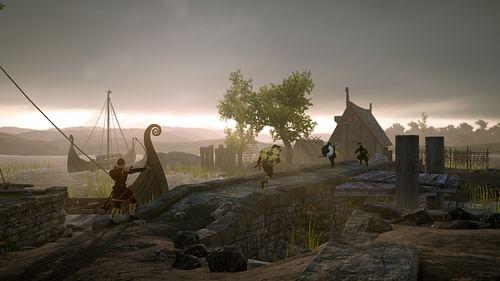
In 873 CE, according to the Annals of Inisfallen, “Barid [Bardr] with a great fleet from Ath Cliath [Dublin] went by sea westwards and he plundered Ciarraige Luachra under ground, i.e. the raiding of the caves” (873). This raid was conducted with Bardr's cousin Oistin mac Amlaib, Amlaib's son, who is sometimes cited as a co-ruler with Bardr, though this is contested. Bardr is credited with being a Viking sea-king, and it is possible that his reputation comes from this raid. It is probable he took his fleet down the east coast of Ireland to strike at modern-day County Kerry on the south-west coast. County Kerry is associated with the designation of Ciarraige Luachra which designated a people of the Kingdom of Munster.
Alternately, it is possible he took his fleet down the rivers which the Vikings had been navigating by that time for almost eighty years. The exact location of where he raided “under ground” has not been agreed on by scholars, and possibly it was another location in the modern-day Munster province. It is agreed, however, that the “raiding of the caves” refers to plundering tombs for treasure. In this, Bardr seems to have reverted to the old methods of conducting military campaigns which prevailed before the coming of Amlaib.
This possibility gains more weight with the next entry for Bardr in the annals, which describes the sack of Armagh in 879 CE by “heathen” forces from Dublin. Bardr's name is not mentioned, but as King of Dublin in 879 CE, he would have either led the expedition or commissioned it. In this 879 CE raid, the abbot and lector of Armagh were captured and held for ransom.
The last entry on Bardr's reign – and life – is the entry in the annals from 881 CE, which describes his raid on the oratory of the saint Cianan or St. Ciaran and his death – either by drowning or burning – shortly afterwards. The oratory of St. Cianan in Duleek (County Meath) is the most probable site, and the entry claims it was destroyed “by foreigners” and that afterwards Bardr, “a great despot of the Northmen, was killed by St. Cianan” (Annals of Ulster, 881). The Annals of Ulster claim that he drowned at Dublin following the raid while the Annals of the Kingdom of Ireland (also known as the Annals of the Four Masters) and Chronicon Scotorum state that he was “killed and burnt” after the raid. All of the sources attribute his death to a miracle enacted by the saint whose oratory was desecrated.
Conclusion
Although the sources on Bardr's reign are obviously biased and must be interpreted with care, there is every reason to believe they are accurate when it comes to this particular king. The actions ascribed to Bardr fit with a paradigm of the earlier raids on Irish churches and monasteries and involve some of the same sites as military campaigns by his uncles and father.
Bardr the sea-king of Dublin most likely gained his reputation from his 873 CE raid and then enhanced upon it through traditional hit-and-run raids which would have supplied him not only with ready cash and food supplies but an abundance of citizens who could be sold as slaves. The ability of Bardr's brother and successor Sichfrith to wage his campaigns after Bardr's death attests to considerable resources which most likely came from Bardr's financial successes in the slave trade of medieval Viking Dublin.
